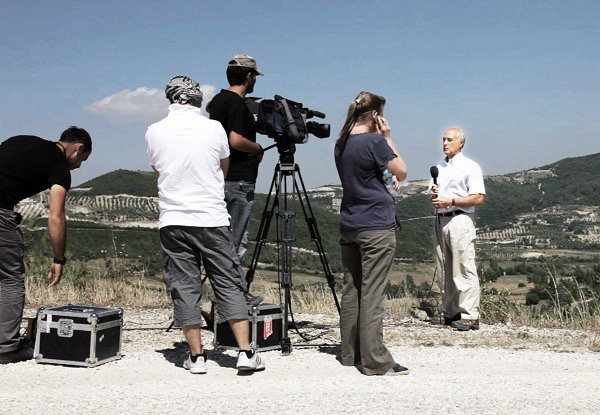Emanuel Licha
dal 24/5/2012 al 6/7/2012
Segnalato da
24/5/2012
Emanuel Licha
Uqbar - projectspace, Berlin
How Do We Know What We Know? The two recent films, as well as research material for his new feature-length documentary film, examines the work of 'classical' journalism, the kind that relies mostly on rarely contested reports from the field by war correspondents.

Images are the tools and weaponry of warfare. In itself this is not new,
but what is undoubtedly new is the way their sources have multiplied.
Now, then, is a propitious moment for examining the work of "classical"
journalism, the kind that relies mostly on rarely contested reports from
the field by war correspondents. The entire edifice around this media
coverage already seems a little out of touch and may soon be left
behind: special correspondents, TV crews, satellite trucks, hotels full
of war correspondents, news flashes and breaking news, the news show's
dramatic jingle...
What is a "good" image of conflict? Where are they made and how will
they be made tomorrow? How can we critique them with other images? Media
production and dissemination create systems in which we are caught and
to which we contribute more or less voluntarily. What we can try to
describe are the details of these systems, sometimes benign in
appearance, as a way of thinking about them and perhaps of loosening
their grip.
The exhibition at uqbar will feature two recent films by Emanuel Licha,
as well as research material for his new feature-length documentary film.
In /How Do We Know What We Know?/(2011, 17 min), the journalist in the
studio talks to the special correspondent who couldn't get into the
conflict zone that is the topic of the news report he put together out
of amateur footage. Just a few years ago, one still heard it said that
the media decided when a conflict started: it began the moment
journalists arrived on the scene. The rapid growth in the amount of
images shot by the protagonists themselves, in combination with their
almost immediate broadcast, has modified this equation. Shot at the
turkish-syrian border during the early moments of the Syrian uprising,
the film reflects on how images of conflict are built.
/Mirages/(2010, 20 min) focuses on a mock Iraqi village in the middle of
the Mojave desert in California. Conceived and used by the US Army for
the training of the troops before being deployed in Iraq, this village
was built and is operated by Hollywood professionals. The extras playing
the roles of the inhabitants are hired among members of the Iraqi
diaspora in the US. This training facility is an optical device. It is
used not only to train soldiers for combat, but also as a device to
guide their gaze. It familiarizes them with the "reality" of Iraq, as it
is fictionalized by the Army and Hollywood. Soldiers are trained to
recognize the enemy, to differentiate the "good people" from the
terrorists and taught that every Iraqi is a potential enemy. It is also
used as a narrative tool to produce a war utopia, through operations of
framing and the training of the viewer via the media workers who are
welcome to cover the activities of the facility.
When they visit this mock Iraqi village, journalists are housed in a
hotel that is part of the simulacrum. This is where the film crew stayed
when shooting /Mirages/. This experience leads to the idea of further
investigating the roles and functions of hotels in warfare. The project
/Hotel Machine/is actually in production, and the exhibition at uqbar
displays some introductory material such as a film teaser and a series
of small photographs of interiors of some of the "war hotels" that will
appear in the film. "War hotels"are spaces where journalists are able to
interact with other protagonists of the conflict: politicians,
negotiators, experts and military officials, but also other journalists.
This is also where images of war are fabricated and from where they are
put in circulation, and where a certain "truth"about war is produced and
replicated.
The two films and the teaser are presented as a single projection in a
continuous program. The experience of the spectator is interrupted every
five minutes by an invasive music: the audio piece /Jingles/(2011)
features brief audio jingles from the news program of major TV networks,
such as BBC or Al-Jazeera. These loud musical interludes interfere with
the spectator's experience, as reminders, like a cuckoo clock would do,
of time passing and the continuous occurrence of world events. Those
news programs punctuate our days, and at uqbar they also punctuate (and
disturb) the spectator's visit.
The exhibition takes place in cooperation with the Embassy of Canada in
Berlin.
The artist thanks the Canada Council for the Arts for its support.
*Emanuel Licha* is an artist and filmmaker. His recent projects enquire
into the means used to observe and report on violent and traumatic
events. After obtaining a master's degree in urban geography, Emanuel
Licha studied visual arts at Concordia University in Montreal and the
École nationale des beaux-arts in Lyon. He teaches film practices at the
École nationale supérieure d'architecture de Paris-La Villette and is a
PhD candidate in Visual Cultures at Goldsmiths College, University of
London.
Image: How Do We Know What We Know?, 2011. Video still
Opening: Friday, May 25, 2012, 7 p.m.
Artist Talk: Friday, May 25, 2012, 8. p.m.
Uqbar
Schwedenstrasse 16 | D - 13357 Berlin
Opening Hours: Saturdays 3 -6:30 p.m.



